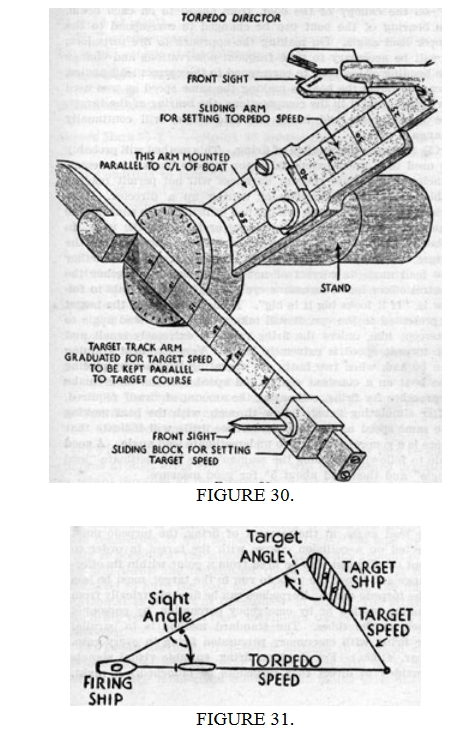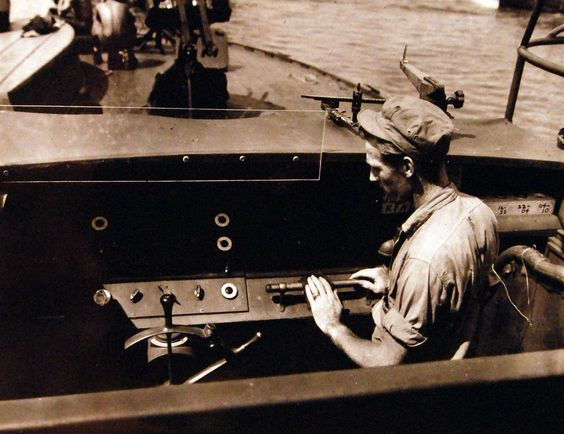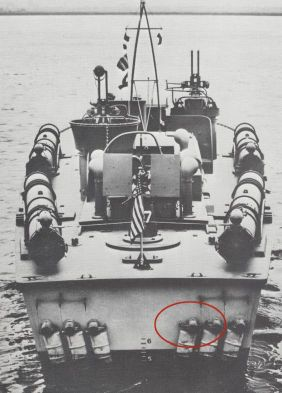Quote of the Day
A torpedo?...You don't really know what you're askin'. You see, there ain't nothin' so complicated as the inside of a torpedo. It's got gyroscopes, compressed air chambers, compensating cylinders...
— From the movie The African Queen. Charlie is answering Rose's question "Could you make a torpedo?" As an old torpedo engineer, I appreciate that answer.

Figure 1: PT Boats Launched the WW1 era Torpedo Mk 8. (Source)
I read quite a bit of World War 1 (WW1) and World War 2 (WW2) naval history. Recently, I have tried to specialize my readings to torpedo launch platforms. I have seen scant little on torpedo fire control on PT boats during WW2 (Figure 1). While doing some history-related searches on Youtube, I discovered this video (Figure 2) that does an excellent job of showing how torpedoes were launched from PT boats – start watching at 30:45 minutes.
| Figure 2: Good Video Showing How PT Boats Launched Torpedoes. |
It is interesting that standard torpedo tubes (i.e., launch the torpedo with a black powder charge) were replaced with a simple cradle that dropped the torpedo off of the side of the boat (Figure 3).

Figure 3: Torpedo Mk 8 launched from a cradle. (Source)
WW2 PT boats generally carried four torpedoes when configured for anti-ship duty. A single torpedo sight was used to aim all four torpedoes. The torpedoes were launched when the PT boat had been steered in the direction you wanted the torpedoes to go. Attacks were normally made with multiple torpedoes that were launched with their gyro angles set to provide a slight spread off of the ship's course to help compensate for any errors and to provide a higher probability of a hit. Figure 4 shows how the torpedo gyro angles are used provide the required spread.

Figure 4: Diagram of the Torpedo Spread from the PT Boat. (Source)
There are some excellent documents on how the torpedo fire control problem was solved using mechanical calculators. These mechanical calculators are very similar to those I discussed in this post on torpedo fire control during WW1.
- Torpedo Angle Solver Mark 7
- Mk8 Torpedo Angle Solver (Used on Submarines)
- General Torpedo Firing Procedures
- Manuals on Basic Fire Control Mechanisms
- Basic Torpedo Math
Figure 5 shows a typical torpedo director, which I think of as an analog trigonometry calculator.

Figure 5: Graphics of the PT Boat Calculator. (Source)
The stationary arm of the director is mounted parallel to the centerline of the PT boat. The stationary arm is toward the top of Figure 5.
Figure 6 shows a photograph of a Torpedo Director Mark 31 for a PT boat.

Figure 6: Mark 31 Torpedo Director. This director is was designed for use with the Torpedo Mk 8. (Source)
Figure 7 shows the Torpedo Director Mark 31 on a PC boat.

Figure 7: Torpedo Director Mark 31 (upper right-hand side of photo) mounted on a PT boat. (Source)
In theory, a PT boat could accurately fire its torpedoes without a director by using the following procedure:
- set the PT boat speed equal to the torpedo speed.
- adjust the course of the PT boat so that the target maintains a constant bearing.
- launch when the target is within the operating range of the torpedoes; the closer the better.
- Steer away from the torpedo immediately after launch.
I read this procedure within a PT board document, but I do not recall where.

I’m a long standing admirer of WWll P.T. boat warfare. Of late I have been focusing on torpedo launching and wondered about aiming from a somewhat unstable high speed platform. I am delighted to have found this contribution, as it is very informative.
As I profoundly lack math talent I am reluctant to comment on the subject matter. The single question in my mind is range to target based on the angle of the torpedo spread. I suspect there was a pre-established preferred range to target to make the math work effectively. Also, like most weapons systems, there was likely a maximum range for torpedo travel before running, no pun intended, out of steam.
Thank you for publishing this commentary. It filled a knowledge void and satisfied my curiosity.
Hi Rascal01,
I bet your math talent is better than you let on. You ask a very good question that shows that you have insight into the torpedo fire control problem – how does range affect the firing solution? It turns out that target range does not affect the solution! Years ago, I wrote a Wikipedia article on this subject, and I will refer you to a paragraph in that article (Torpedo Data Computer). The mechanical directors did need to know the target speed. There are a number of ways to estimate the target speed, including radar (which would also give range), matching PT boat speed to target, or simply guessing based on how the target was moving through the water. I am sure that in many cases they got as close as they could to minimize the significance of any errors. Submarines had a more sophisticated approach that counted the number of target prop beats per minute (related to ship speed) and using their on-board analog computer to refine their estimate. I should mention while range does not play a role in determining the torpedo firing angle, it is important to ensure that the torpedo is fired when the target is within its operational range.
Thanks for writing me. I enjoy the comments.
mark
P.S. I believe you can see the torpedo aiming director above the sailor's hat.

The splay of the torpedoes can be seen in this image.

Here is an excerpt from the book At Close Quarters: PT Boats in the United States Navy that mentions a PT boat skipper estimating the target speed and using the director.
mark
I'm a volunteer with the New Orleans WW2 Museum, particularly with the restored PT 305. We're trying to find the "angle solver" used to calculate the angle of a torpedo attack. Any leads?
Thanks for the effort...
I don't have any leads, but I will look around at various memorabilia sites. At least I know what to look for …
By the way, nice work on PT 305.
mark
In teaching boating, I have taught that if the angle remains the same, you are going to hit. So the second way makes sense to me.
Thanks for your comment.
I just finished reading the book PT105 by Dick Keresey and this is the method they used. Most PT boats during WW2 were issued old, slow, WW1-era torpedoes (Mk 8) and matching the torpedo's speed actually involved slowing down a bit; the PT boats followed the exact procedure described in the post. I am sure this procedure was easier in practice than trying to use the director. A faster torpedo would have made this procedure less practical.
As far as boating, I remember reading how the radar operator on MS Stockholm reported the SS Andrea Doria was on a constant bearing just before the collision. The article stated that radar was new to commercial ships at that time and they did not trust its output.
mark
To my regret, I never asked my father for specific details of what he did during WW2. He was torpedoman's mate first class Joseph A. Powers of Worcester Massachusetts. In 1942 and 1943 he was in the Solomon Islands. He was part of the same flotilla as the 109. I do not know his boat number. He was stationed at Talagi, Rendova and New Georgia. I have searched the internet and can not find the job description for a Torpedoman's Mate first Class. He had told my deceased older brother that he also manned the fifty caliber machine guns when they were "barge busting in the slot". I know that he came down with malaria and was discharged in 1945 from the jet propulsion laboratory at MIT.
There are many things that wish I had spoken with my father about – I understand your regrets. PT boats were not very successful using their torpedoes to engage warships, but they proved very successful at interdicting barge traffic. I would recommend reading PT105 by Dick Keresey. He does a great job describing PT operations.
mark
Thank you, I will do that. Back in the 1950s I was watching a TV program called Navy Log and they told the story of the 109. My father told me that he knew JFK from the war and that they were part of the same flotilla. I was around 10 years old at the time. About fifteen years ago Senator Edward Kennedy obtained my father's service records for me. They told me where he was stationed and his rank but no details of what he actually did.
PT105 and PT109 were part of the same flotilla, at least for a time. So PT105 may provide you with some additional insight as to what your father experienced.
mark
Thank you again. I just ordered the book from Amazon. If I had a time machine, I would ask him a whole bunch of questions. My oldest brother passed away in 2010. He had spent 21 years in the army and I spent time with him before he died. I did get to ask him what he did. He was 2nd Infantry in the Korean War and fought in the Battle of Heartbreak Ridge. He was with the Team 51 MACV at Bac Lieu in Viet Nam.
I am writing a book about my father-in-law's first 5 months of the war. His name was Charles Beckner. He was in PBY PatWing 10 on Dec 7/8, but manages to obtain an assignment to MTB 3 in early January. He was a pharmacist mate and gunner (yes) on PT 34. He received a silver star from MacArthur after his "break out". My question is simple: what positions are torpedo tubes 1-4. Thanks
Hmmm … the document Motor Torpedo Boats: Tactical Orders and Doctrine has the following table.
Does this help? I should mention that PT34 was a 77 foot Elco, just like the PT20 referenced above.
mark
I have simulated torpedo directors of the early 1900s. http://dreadnoughtproject.org/tfs/index.php/Category:Torpedo_Director
Sorry- I hadn't noticed your gracious inclusion of my work in your earlier post.
Hi Tony,
Your work on WW1 dreadnoughts is amazing – I recommend it highly to anyone interested in the subject.
mark
Had a mechanical puzzle. I've tried since I was young. That I've never been able to figure out. Each time I look at a pt boat.
The puzzle I've tried solving is. That the muzzle end of the back tube over laps the breech of the front tube. The puzzle I've tried solving. Is how the back torpedo was fired. Without hitting the front tube.
IIRC, The front support of the tubes is a short rack and pinion, and the rear one a rotary column: the tubes could be cranked outward a small angle.
Hi Tony, I believe you are correct and I am just going to add just a bit of detail. The tubes had "trained out" and "trained in" positions." During normal operation, the tubes were trained in. The tubes were trained out for attack. Here is a quote from the book, John F. Kennedy and PT-109.
Note that torpedo tubes were replaced on a number of boats with launch cradles. These simply dropped the torpedoes over the side. The torpedo gyros would put them on the proper course (relative to the boat heading).
Reference
Just for fun, I am including a photo of a UK Dark Class Fast Patrol boat (similar to a US PT Boat) firing a salvo of four torpedoes.
Reference
Do you mind if I quote a couple of your posts as long as I provide credit and sources back to your weblog? My blog is in the exact same niche as yours and my users would definitely benefit from some of the information you present here. Please let me know if this alright with you. Thanks a lot!|
Go ahead. Send me a link to your content. I would probably be interested.
mark
As a radarman in the 1960s on board a destroyer I was taught how to use a vector diagram on a maneuvering board to calculate the launch angle for firing torpedoes. Can anyone help me with how the calculation was done. My old Mk One brain doesn't work as well as it once did.
I can send you some reference links.
Submarine Torpedo Fire Control Manual (link): Covers general use of a MoBo.
Youtube Video on Maneuvering Board Basics: Link
Gene Slover's Torpedo Fire Control Page link: Gene's put an excellent set of manuals online that includes torpedo fire control. I use his stuff all the time for my battleship work.
mark
I was wondering what a torpedoe firing panel looked like on apt boat - single buttons or what? thanks
Ds anyone have a picture of the torpedoe firing panels,instruments for the three Packard engines,etc. thanks